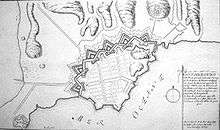Fortifications of Gothenburg
The fortifications of Gothenburg (Swedish: Göteborgs befästningar) were initially embankments along the newly dug city moat, with construction beginning in 1624 under the leadership of 2 engineers, Captain Johan Schultz (Schouten) and Johan Jacobssen Kuyl (Kuhl?), following a design by chief engineer Johan Rodenburg. The works were based upon the well-established Dutch school of fortification.

When Erik Dahlberg took responsibility for Sweden's fortifications in 1676 he implemented Karl XI's wishes for modern bastions of high wall construction. The ramparts were lined with walls of blasted rock and the fortified town of Gothenburg developed with 13 polygonal bastions and accompanying moat, ravelins and 3 city gates (Kungsporten; Nya porten, later renamed Drottningporten; and Karlsporten/Hållgårdsporten).
The demolition of the fortifications began in 1807, and was completed within ten years. The only surviving piece of bastion is Carolus Undecimus Rex (named after Charles XI of Sweden), on the side of the Lilla Otterhällan hill.